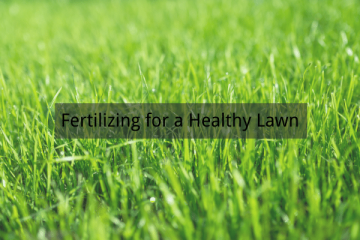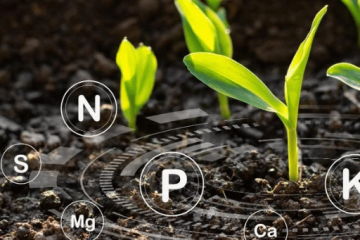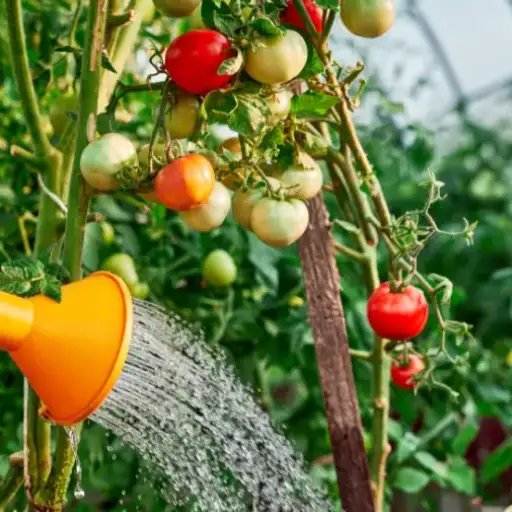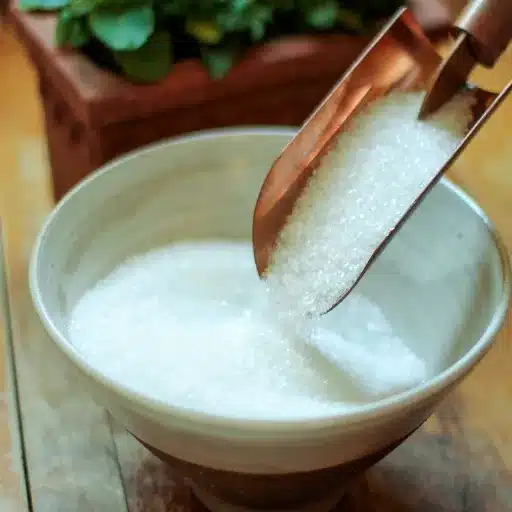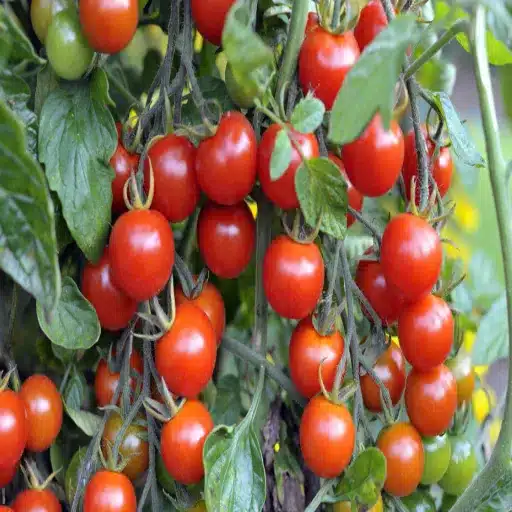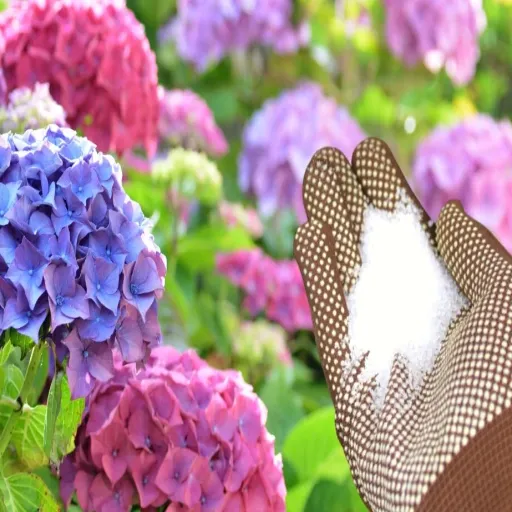Growing healthy, vibrant tomato plants is a rewarding endeavor for gardeners of all skill levels, but achieving consistent results can be a challenge. One often-overlooked yet highly effective method for enhancing tomato growth is the use of Epsom salt. This natural compound, rich in magnesium and sulfur, plays a critical role in supporting plant health, improving nutrient uptake, and preventing common deficiencies. In this guide, we will explore how Epsom salt works, the specific benefits it provides for tomato plants, and practical techniques for its application to maximize your harvest. Whether you’re a seasoned gardener or just starting your tomato-growing journey, this article will equip you with the knowledge to unlock the full potential of this time-tested gardening secret.
What is epsom salt, and how does it benefit tomato plants?

Understanding epsom salt: Composition and benefits
Known as magnesium sulfate scientifically, Epsom salt contains two elements crucial for the health of plants: magnesium and sulfur. Sulfur and magnesium help in the plant’s overall growth and development. Moreover, having magnesium increases the aid of bringing the amount of chlorophyll and energy transfer that occurs inthe cell. For any kind of plant to thrive on yield, the plant needs healthy and strong foliage, and sulfur aids in improving the flavor of tomatoes.
Although tomato plants need magnesium the most compared to other plants, it does indeed aid in efficiently capturing light and enhancing photosynthesis and helps improve the yield of tomatoes.
When sprayed on the leaves, and in some cases, the soil with the help of water, Epsom salt can help get rid of the common problems faced by tomato plants like the yellowing of leaves which happens due to lack of magnesium. Nonetheless, caution does need to be taken when using it with regard to the balance of the soil, thus making it essential for plants to manage their nutrients.
Role of magnesium sulfate in tomato plant health
Epsom salt is renowned for its medicinal benefits. However, magnesium sulfate, commonly known as Epsom salt, performs a critical function for the health of tomato plants and their growth by providing magnesium, which aids in photosynthesis. Photosynthesis is an essential process for plants to create fuel or energy using sunlight, and magnesium plays a vital part in chlorophyll, which is the primary pigment of plants. If there is a lack of magnesium, tomato plants not only face retarded growth, but also lesser fruit yield along with yellowing of leaves which is termed as interveinal chlorosis.
Magnesium sulfate improves the absorption of nutrients, most specifically in acidic soils where magnesium is hard to come by. Epsom salt can be applied as a foliar spray or mixed into the soil based on the plant’s requirements. The leaves directly absorb the solution which helps alleviate magnesium deficiency almost instantly. As a result, foliar applications have been found to be more useful when it comes to dealing with a scarcity of magnesium.
Plants and soils are fully subjected to scrutiny for an in-depth understanding of their scientific properties. Correct application is crucial in this case to avoid negative consequences. Boosting magnesium sulfate dosage may upset the equilibrium of other nutrients within the soil, like potassium and calcium, thus deteriorating plant health. Prior soil tests can help understand if infusing magnesium helps. Subsequently, the observed steps, along with cautious techniques performed by a gardener, stand to enhance the potential benefits of magnesium sulfate while being fully beneficial for tomato plants.
How does epsom salt help in soil nutrient uptake?
When added to soil, Epsom salt, also called magnesium sulfate, improves soil nutrient uptake for plants because of its balancing components of magnesium and sulfur. Magnesium is very much present in greater plant parts that contain chlorophyll. Chlorophyll is a biomolecule responsible for photosynthetic activities in life forms, such as in green plants. It significantly determines the plant’s ability to produce energy and grow—magnesium’s availability decently influences that. In Sulfur, together with components such as sulfur-containing compounds, the element critically assists in creating amino acids, enzymes, and vitamins. Hence, the plant can function better and grow stronger.
Epsom salt dissolves quickly in the soil and immediately releases these vital nutrients in an easily obtainable form for plants. So the plant roots can speedily absorb it, especially Magnesium, well known for improving flowering. Hence, magnesium aids in the promotion of the reproductive process of plants like tomatoes, peppers, and roses. Due to Epsom salt’s presence, plants are better shielded from nutrient deficiencies that may crop up from depleted soil or out-of-balance fertilization.
In some cases, Epsom salt enhances nutrient uptake by improving soil structure, in addition to its other effects on the environment. Magnesium helps reduce soil compaction, which allows water, air, and nutrients to flow more freely to the plant’s roots. However, Epsom salt should only be used as an add-on because using it as the primary fertilizer will not be beneficial. Its use is more effective when other basic nutrients are already at least in sufficient levels and the soil is balanced. For optimal results while avoiding a negative imbalance of nutrients, regular soil testing and careful application are essential.
How can you use epsom salt effectively in your garden?
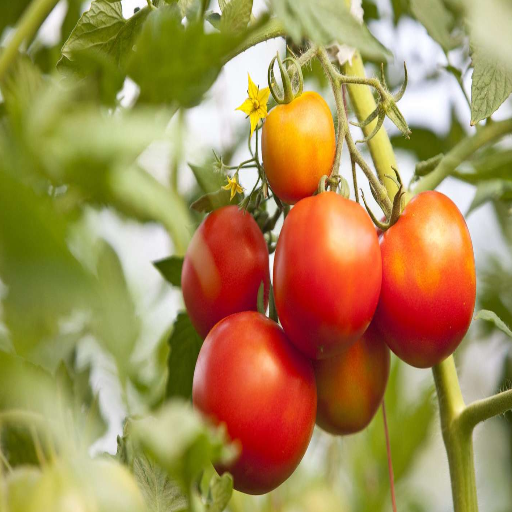
Methods to add epsom salt to soil
- Incorporation into the Soil: Epsom salt can be incorporated into the soil during or after planting. For growing plants, sprinkle the recommended quantity of salt roughly around the base of the plant, avoiding the stem area where it could become overly concentrated. The suggested ratio is one tablespoon of salt for every foot of the plant’s height.
- Watering Incorporation: To prepare a watering solution, add 1 to 2 tablespoons of Epsom Salt to one gallon of water. This mixture can be applied directly to the soil while undertaking routine watering. This method ensures consistent distribution of magnesium and sulfur, making leaching during rainfall or irrigation impossible.
- Fertilizers Delivered Through Leaves: For faster absorption, foliar spray solutions can be prepared with 1 tablespoon of Epsom salt and a gallon of water. The mixture can be applied to the leaves using a garden sprayer or a spray bottle. These solutions are absorbed through the leaves rather than the soil, enabling quicker uptake of nutrients. This technique is particularly useful when plants show signs of magnesium deficiency, such as yellowing leaves.
- Incorporation At Planting: While placing the seeds or using transplant seedlings, mix Epsom salt around the planting hole for under the seed/root ball is one way to achieve stronger initial root growth whilst reducing the transplant shock experienced by younger plants. Incorporating about a teaspoon of Epsom salt should suffice.
- Additions: Compost or Organic Fertilizers: Epsom salt may be combined with compost or organic fertilizers to improve their nutrient value. Apply small amounts, such as half a cup per cubic foot of compost, and mix it to ensure it is evenly spread over the entire growing area.
These strategies can be beneficial to nutrient availability in your garden if implemented cautiously and in moderation, but do not pose a threat to soil imbalance.
Creating a foliar spray with epsom salt
When preparing a foliar spray with Epsom salt, begin by dissolving 1 to 2 tablespoons of Epsom salt in a gallon of water. This dilution is appropriate for most plants because it supplies an adequate amount of magnesium and sulfur without risking damaging nutrient oversaturation. Stir the solution well so that the Epsom salt granules are fully dissolved.
Nutrient uptake through the leaf stomata is better during the cooler parts of the day, so the solution should be sprayed in the early morning hours or late afternoon. This cooling helps prevent quick evaporation, and plant nutrient uptake through the stomata works better during the cool periods of the day. It is important to keep in mind that this foliar treatment is especially useful for plants like tomatoes, pepper and roses, which in fact do well with additional magnesium.
Research shows that feeding Epsom salt to plants correctly addresses magnesium deficiency, which can be verified through yellowing leaves with green veins, also known as interveinal chlorosis. Applying treatments 2 to 4 for weeks at a time tends to improve plant health and growth performance significantly. Even so, Epsom salt should not be overapplied, as it can result in a hazardous buildup that affects the plant and soil negatively.
Recommended epsom salt quantities and frequency of application
As with any plant care regimen, dosage and timing of application when using Epsom salt needs to be precise in order to acheive optimum results without causing any harm. For most garden plants, a typical recommendation provides a dosage of 1 tablespoon of Epsom salt dissolved in 1 gallon of water to be poured around the base of the stems fortnightly to monthly during peak growth phases. For potted plants, the dosage should be lowered to 1 teaspoon per gallon of water to prevent oversaturation.
Changes within plant types might require specific adjustments. Highly responsive to magnesium, tomatoes and peppers could benefit from foliar sprays. A dose of 1 tablespoon per gallon of water applied directly to the leaves bi-weekly could help alleviate magnesium deficiency. A more conservative approach of 1/2 tablespoon per gallon of water should suffice for flowers and ornamental plants to avoid over-fertilization.
Prolonged application of Epsom salts in plant care can lead to an imbalance of soil nutrients, which is why monitoring the magnesium levels periodically is essential. Combining the results with regular soil testing allows adjustment of application frequency or dosage, guaranteeing that the plants are thriving while eliminating negative impacts.
What are the signs of magnesium deficiency in tomato plants?
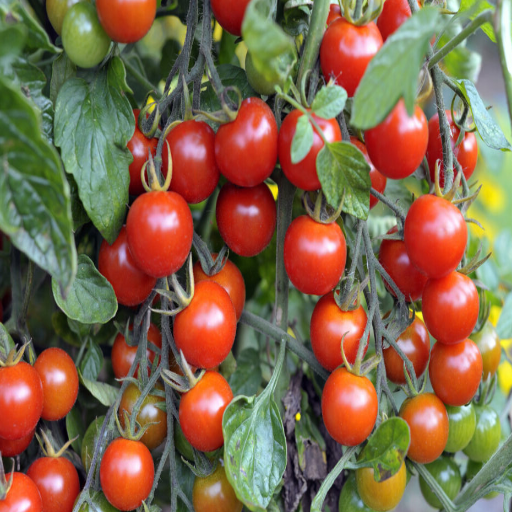
Identifying deficiency symptoms in tomato leaves
In tomato plants, the lack of magnesium manifests itself as interveinal chlorosis. This is the condition whereby leaves, especially the older ones, turn yellow in the areas situated between the veins of the leaves whilst the veins themselves remain green. This symptom appears first on lower leaves, and, over time, yellowing can progress to more severe discoloration, even necrotic spots where parts of the leaf die. These symptoms may lower the efficiency of photosynthesis, which will directly affect the vigor of the plant and the development of the fruit.
In tomato plants, one of the dire Mg deficiency issues is reduced fruit′s yield and quality to be on the lower end. Several studies showed that Magnesium does play an important role in the production of chlorophyll, which is required in the process of photosynthesis and energy capture. If magnesium is not sufficient, then there will be difficulty in the production of sugars and the storage of energy, which will lead to stunted growth and, hence, smaller and less flavorful fruits. In addition, magnesium deficiency also leads to secondary issues such as poor nutrient uptake, which becomes a challenge due to the plant’s weak condition, making it hard to absorb other essential nutrients such as potassium and calcium from the soil.
When diagnosing magnesium deficiency, other factors like nitrogen deficiency and environmental stresses (drought) should be evaluated first. Soil testing is one of the most accurate ways to measure nutrient deficiency, as it reveals both the amount of magnesium present and the overall soil fertility. Diagnosing symptoms early on and administering Epsom salt or fertilizers containing magnesium can help mitigate any negative impacts and promote growth in yielding tomato plants. Magnesium deficiency, once identified, should be controlled by active observation and following nutrient management guidelines.
Common causes of magnesium deficiency in plants
The lack of magnesium in plants can be due to multiple issues in the environment, soil, or even management practices. The most frequent issue appearing is a lack of magnesium in the soil, frequently found in sandy and acidic soils where magnesium is leached away. Another reason is the overuse of fertilizers containing potassium, which causes a nutrient imbalance as high concentrations of potassium inhibit magnesium uptake through competitive ion exchange processes.
The depletion of magnesium seems to be more acute in intensive cropping systems where crops are grown repeatedly without adequate reimbursement to the soil. Also, a lack of organic soil nutrients increases the problem because organic matter aids in the preservation of vital cations such as magnesium. Also, irrigation methods that result in waterlogging can interfere with root functioning and, therefore, nutrient uptake.
Extreme and protracted droughts plus extremely low temperatures can worsen the situation, because of their effect on magnesium mobility within the plant. For these reasons, recognizing these factors and applying better management techniques can help sustain optimal plant health and productivity. Regular soil evaluation, controlled fertilizer use, and moderate pH levels in the soil provide balanced protective mechanisms.
Can epsom salt prevent blossom end rot in tomato plants?
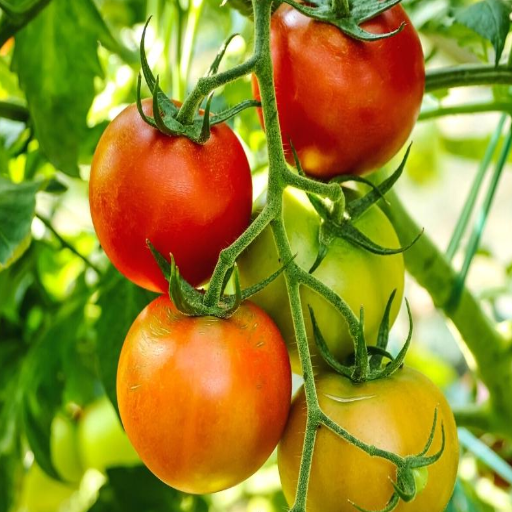
Understanding the causes of blossom-end rot
Blossom-end rot primarily results from a blossom-end calyx depression in the developing fruit caused by a localized calcium deficiency. Calcium is one of the most important nutrients of cell wall construction, and its deficiency can result in cell delinquency and necrosis—leading to sunken, dark lesions on the blossom end of the fruit. While an insufficiency of calcium is the direct reason for blossom end rot, many environmental and physiological factors add to the problem.
Inconsistent watering of the plants administered as stress water is one of the prominent issues, as it makes the entire calcium supply dislocate. Since calcium is funnelled to the fruit in the xylem sap stream, any deviation from normative water supply—due to drought stress or over watering—impedes calcium flow. Moreover, excessive nitrogenous fertilizers increase the growth of non-functioning tissues, which reduce the available calcium for the fruits. Soils with low pH and pore space or salinity can also restrict the uptake and availability of calcium, thereby having significant impacts. Also, highly calcium-deficient soils may worsen the situation by changing the temperature and adding extreme temperature changes that affect roots and calcium ions.
Such factors highlight the need for avoiding over-fertilization and maintaining consistent moisture levels, soil conditions, and moisture control to prevent blossom-end rot efficiently.
The role of calcium and other nutrients
Calcium is essential in the development of plants because it helps maintain the plant’s cell wall and membrane structure. It also helps control enzymes, stabilize membranes, and assist in the signal transduction pathways in the plant’s cells. Not having calcium can result in poor cell structure, increased vulnerability to infections, and physiological issues like blossom-end rot. However, it is important to note that calcium does not work alone. He collaborates with other nutrients in achieving the overall health of the plant.
For instance, Magnesium serves as the core component of chlorophyll molecules and aids in photosynthesis, Calcium assists indirectly by using energy production for nutrient transport. Equally important, osmosis and stomatal processes, which maintain water within the plant, are also controlled by potassium. Though required minimally for vegetative growth, nitrogen is harmful; when tissue development outpaces calcium supply, calcium deficiencies become prominent.
Studies conducted in the last few years have highlighted nutrient balance maintenance, claiming nutrient ratios beyond a certain point limit calcium’s uptak and translocation, which proves detrimental. As an example, potassium or ammonium ions in abundance may lead to competition for absorption at roots, which in turn limits access to calcium. Integrated soil fertility management paired with regular checks on soil nutrient quantities helps fully utilize calcium and value mentary nutrients for plant health.
Epsom salt as a preventive measure for blossom end rot
In gardening, Epsom salt is seen as a supplemental source of magnesium because of its chemical properties of magnesium sulfate. But there is an ongoing argument on whether or not it helps equally for tomatoes, peppers, and squash in preventing blossom end rot (BER). The deficiency of calcium within the fruit during its early developmental stages mainly causes peak blossom rot, but environmental factors such as irregular watering and excessive fertilizer application also heavily affect it.
Due to the synergistic relationship between magnesium and calcium, extra amounts of Epsom salt in soil already lacking calcium could augument blossom end rot BER syndrome because magnesium is needed to carry out photosynthesis. Studies suggest that precise tests on soil should be done instead of directly applying an amendment like Epsom salt to avert nutrient imbalance heightening dysregulatory outcomes towards nutrient deficiency.
To best lessen the implications of calcium deficiency alongside recurrent watering and optimal soil pH boundaries, adding calcium-rich additives such as gypsum or calcium nitrate is helpful. Epsom application should only be used in scenarios when there is a confirmed lack of magnesium so energy balance can properly synergize to bolster plant health.
Should you use epsom salt for other plants, like tomatoes and peppers?
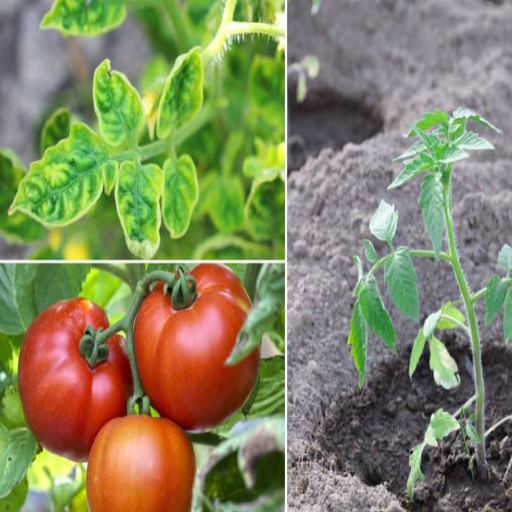
Benefits of epsom salt for plants beyond tomatoes
When used properly, Epsom salt has measurable benefits for a variety of plants. For peppers, augmenting plant vigor and boosting fruit set can be achieved through magnesium supplementation, as many soils with low nutrients tend to have magnesium deficiencies. Aided by magnesium, which catalyzes the formation of chlorophyll and activates certain enzymes required for energy transduction, the plants prosper. This enhances and improves the vigor of a plant’s foliage, supporting a greater yield and integrating altogether green and healthy bordering. Thus making magnesium deficiency and soil depletion a not common issues.
Epsom salt aids in the blossoms’ production and their color for flowering plants like the greenish-red rose, too. Epsom salt augments the growth of roses by providing sulfur, an important building block for proteins and active enzymes. Of note, magnificent asters and the like would be dusky to class them as such. Even leafy greens, say lettuce and spinach, also boom with the fact that additional magnesium speeds up their growth and further enhances them to be more nutritionally rich.
Though Epsom salts have their returns, gauging the tasks assigned unto them matters, with regards to magnesium sulfate, needing steps such as drawing out the soil’s composition and examining the provided nutrients echalon, all with the aim of ascertaining the worth for using them. Furthermore, levity in precision application, be it tailoring water or soil to the roots, maintain the health of the soil while achieving great results.
Considerations for pepper plants and other vegetables
When using Epsom salt as a magnesium supplement for peppers and other vegetables, it is necessary to consider the specific crop characteristics and environmental conditions to achieve the best results. In the case of pepper plants, magnesium is essential in the formation of chlorophyll and hence affects photosynthesis and the growth of the plant. A lack of magnesium can result in the yellowing of leaves, particularly in older leaves, known as interveinal chlorosis.
For optimal results, the general guidelines suggest dissolving 1-2 tablespoons of Epsom salt in a gallon of water for foliar sprays or 1 tablespoon per plant for ground application as a soil amendment. Before supplementation, a soil test is recommended to eliminate magnesium deficiency to avoid corrective steps that would destabilize beneficial nutrient levels. Also, high amounts of magnesium can make it difficult for a plant to absorb other important nutrients like potassium and calcium, which are vital for healthy fruit growth and overall plant health.
For other vegetables, the demand for magnesium may differ by species, growth stage, and soil conditions. Crops such as tomatoes and beans might display moderately similar magnesium requirements, which need attention for signs of deficiency. Deficiency reasons, seasonal changes, method of irrigation, and pH of soil (which is most favorable between 6.0 and 7.0 for nutrient availability) also need to be considered in management plans. A well-rounded fertilization approach helps to provide adequate levels of nutrients, allowing for the maintenance of balanced plant health and increased crop yields.
Integrating epsom salt into your vegetable garden routine
Epsom salt or magnesium sulfate can be a useful supplement for plant health when carefully incorporated within a gardening regimen. Sulfur’s contribution to plant development as an enzyme producer and magnesium, being an important part of chlorophyll, aids in photosynthesis and is equally indispensable for plant growth. Magnesium deficiency can be integrated into Epsom salt, but overuse can interrupt the balance of nutrients within the plants. Before planting, apply a half cup of granular Epsom salt over the soil and use it as a top dressing to ensure equal distribution.
Soil tests can help confirm any possible suspicion for diagnosing a problem and can help guide in case any concerns are raised. On the more general side, Epsom salt can be effective when used in a gallon of water with one or two tablespoons of solution. Adding nutrients via foot spray or soil drench every four to six weeks can yield results. Addressing further concerns, spending less time withholding further nutrients for easier absorption via leaves enables leaves bare instant nutrient access, which addresses deficiency.
Studies show that flowers and fruits from crops such as tomatoes, peppers, and even roses greatly improve with periodic “boosts” of magnesium, as they greatly improve in terms of production, vibrancy, and color. However, boosting magnesium levels beyond a certain threshold can be counterproductive, as it can result in soil accumulation, which can impact its fertility. Magnesium sulfate, better known as Epsom salt, is to be integrated as part of a holistic nutrient management system. Ensure proper irrigation alongside plant response monitoring to guarantee the best results.
Reference Sources
Frequently Asked Questions (FAQs)
Q: What is Epsom salt, and why is it used in gardening, specifically for tomatoes?
A: Epsom salt, also known as magnesium sulfate, is used in gardening to provide essential nutrients like magnesium, which is crucial for plant growth. Many gardeners use it on tomatoes to help them produce lusher and greener foliage, improve phosphorus uptake, and ensure great harvests.
Q: How should I apply Epsom salt to my tomato plants?
A: You can dilute Epsom salt in water and apply it to your tomato plants every two weeks during the growing season. Another method is to put Epsom salts in the hole when planting seedlings to ensure they have access to magnesium from the beginning of the season.
Q: Can Epsom salt help with blossom-end rot in tomatoes?
A: Blossom-end rot is caused by a lack of calcium in the soil, not magnesium. While Epsom salt won’t directly fix this issue, ensuring an ample supply of calcium in the soil is crucial. It’s also good to avoid adding too much nitrogen, which can exacerbate the problem.
Q: Is a soil test necessary before using Epsom salt on tomatoes?
A: Conducting a soil test is highly recommended. It helps determine the existing levels of magnesium and calcium in the soil, ensuring that you don’t over-apply Epsom salt, especially in soils that have plenty of these nutrients naturally occurring.
Q: How does Epsom salt affect seed germination and early plant growth?
A: Adding Epsom salt at planting time can help improve seed germination and early growth by making magnesium available to the plant right from the initial planting.
Q: Can Epsom salt be used in conjunction with other fertilizers?
A: Yes, Epsom salt can be used alongside other fertilizers. It’s essential, however, to balance the nutrients and ensure there’s not too much nitrogen that could hinder calcium uptake, affecting plant health.
Q: What are the effects of heavy rains on Epsom salt application?
A: Heavy rains can wash away magnesium, making it less available to the plant. Regular applications of Epsom salt during the growing season can help counteract this issue and maintain nutrient levels.
Q: Are there any disadvantages to using Epsom salt in tomato gardening?
A: Overuse of Epsom salt can lead to an imbalance in soil nutrients and potentially harm plants. Always follow recommended guidelines and perform a soil test to ensure that magnesium is required.
Q: Why do some gardeners add Epsom salt to the soil when planting rose bushes?
A: Many gardeners find that Epsom salt can enhance the color and quantity of blooms by boosting magnesium levels, which is essential for the formation of plant cell walls and overall plant vigor.

